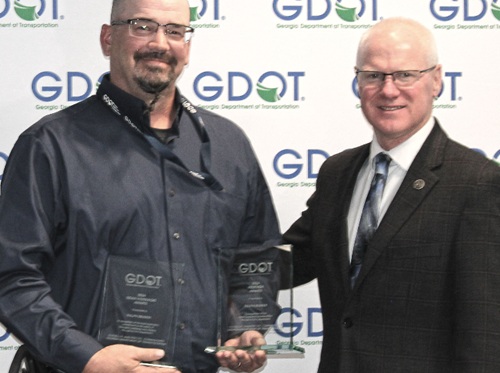A new research partnership between the Arizona Department of Transportation and the state’s three public universities seeks to help the agency stay at the forefront of innovation, nurture a new generation of transportation professionals, and support Arizona’s economy.
[Above image by Arizona DOT]
The Arizona DOT said it entered into an agreement with the newly-formed Arizona Transportation Institute or AZTI to leverage the expertise of faculty and students at the University of Arizona, Arizona State University, and Northern Arizona University.
Through the AZTI, based at the University of Arizona, faculty at the three universities will submit proposals to conduct transportation research, with the AZTI encouraging collaboration among universities.

This collaboration aims to foster innovative transportation technologies, planning methods and engineering approaches that can improve Arizona’s transportation system and create better communities, the agency said.
“We’re tremendously excited to partner with talented faculty and students in a way that can improve the lives of Arizonans, support our state’s economy and promote transportation engineering as an exciting and essential career,” said Jennifer Toth, Arizona DOT director, in a statement.
“Arizona will benefit tremendously from establishing this coordinated structure for the brightest minds at the three universities to optimize transportation, a huge quality-of-life issue for every resident,” added AZTI Director Yao-Jan Wu, a University of Arizona professor of civil and architectural engineering and mechanics.
University researchers are already working on a number of research projects requested by Arizona DOT, including:
- Examining the impact of heavier and oversize vehicles on roads and bridges – in comparison to other vehicle types – in terms of construction, maintenance, and repair costs.
- The development of “Arizona-specific factors” to aid Arizona DOT’s decisions on the location and types of safety countermeasures intended to reduce the frequency and severity of motor vehicle crashes.
- Studying whether landscaping and vegetation management that encourages recovery of native plants following wildfires can reduce repair and maintenance costs for roadways.
Many state departments of transportation are involved in a wide variety of partnerships with universities and colleges in their regions.
For example, in August, the North Carolina Department of Transportation, in partnership with N.C. State University’s Institute for Transportation Research and Education, launched a “groundbreaking project” aimed at mapping unmarked burial sites belonging to historically marginalized groups statewide.
That research project, led by NCDOT’s Office of Civil Rights and N.C. State, began this summer and will extend through the summer of 2026. It will focus on identifying and mapping Indigenous burial sites, graves of formerly enslaved individuals, and historic African American cemeteries.
The agency said unmarked burial sites have long faced disproportionate risks and vulnerabilities as North Carolina’s popularity leads to increased commercial and residential development and transportation projects; with experts concerned that development coupled with more frequent storms could make it more difficult to identify and preserve these burial sites.
Meanwhile, the college of engineering at the University of Missouri established the Missouri Work Zone Safety Center of Excellence or “MOWZES” in October 2023 to develop behavioral, educational, engineering, and technology solutions to achieve zero fatalities and serious injuries in highway work zones.
The first focal point for that new center – which is supported by over $1.5 million in combined funding from the Missouri Department of Transportation and the Federal Highway Administration – is the five-to-seven-year long I-70 project, which aims to improve the east-west transportation corridor connecting St. Louis and Kansas City.
 States
States
Georgia DOT Foreman Receives Two Heroism Awards
January 2, 2026 States
States

